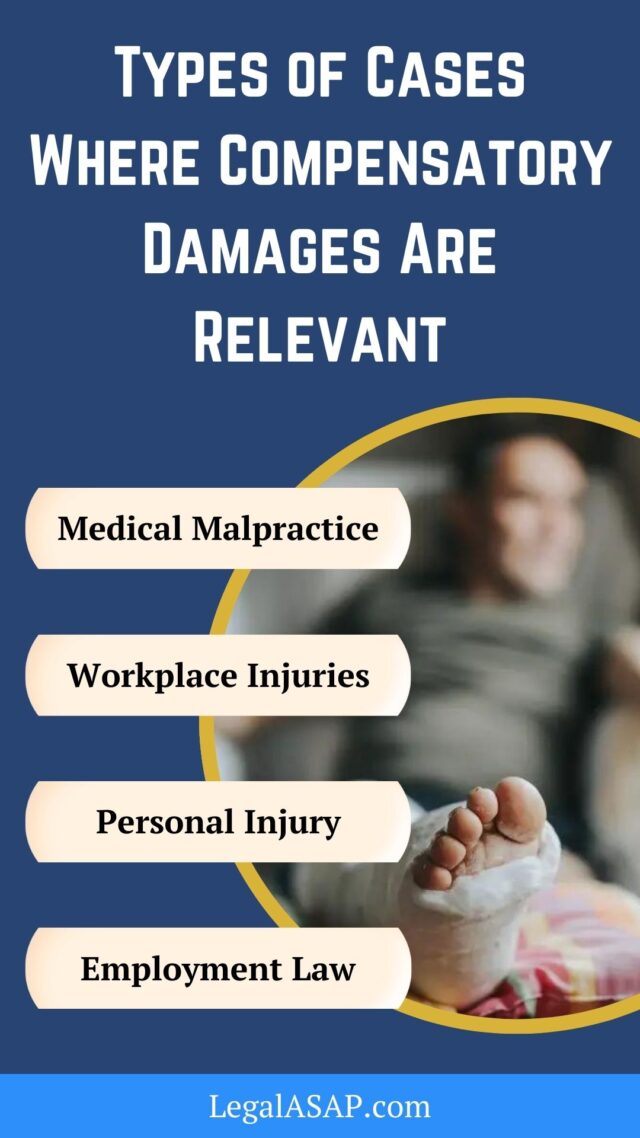Compensatory damages in personal injury law are one of the types of compensation awarded to a plaintiff after a legal claim. These damages seek to cover a victim’s losses, tangible and intangible, after an accident involving negligence.
Not only in personal injury law, but compensatory damages are relevant in several other legal areas, including:
Compensatory damages are not easy money. Several aspects of negligence must be proven for the law to award you damages for your case.
It may be in your best interest to consult with a personal injury attorney before signing any papers. Several parties like insurance companies want to limit how much damages you’ll earn to preserve their profits.
You never know the true damage amounts you’re owed without consulting a legal specialist about your case.
Free Personal Injury Evaluation
Weren't at-fault for your accident? Click here to speak with a nearby attorney for FREE about your personal injury claim.
or call (888)-927-3080
How to Qualify for Compensatory Damages
In the United States, the victim must prove that a loss or injury has occurred due to another party’s negligence or illegal conduct. Compensatory damages are intended to compensate for the loss the victim or plaintiff has suffered.
To qualify for compensatory damages, you must prove the negligent party failed to perform their duty of care to the public. Their failure then directly resulted in your injuries and losses.
Some state laws may impact the result of personal injury cases and may vary in settlement amounts. For instance, some states have higher averages and settlement compensations for neck and back injuries.
However, the state may reduce your compensatory damages due to comparative negligence laws.
If you were deemed partially at-fault, the court deducts some amount of damages paid to you from the defendant, according to your percentage of liability. Some states work on a modified form of comparative negligence where if you’re more than 50% at-fault, you cannot receive damages from your accident.
The Two Types of Compensatory Damages
Compensatory damages are divided into two broad classes—economic and non-economic damages. These two compensatory damages are also known as special damages and general damages respectively.
Economic Damages
Economic, or special damages are straightforward to calculate because they’re based on actual damages the victims suffered from the accident. These damages are tangible losses that must be reimbursed, such as:
- Property damage (car, house, personal items like cell phone, etc.)
- Lost wages from not being able to work due to injuries
- Lost earning capacity, such as inability to receive promotions at work
- Current and future medical expenses (bills, out-of-pocket medicine, etc.)
- Rehabilitation costs
- Funeral and burial expenses
Economic damages are usually physical losses that can be proven due to physical evidence backed up to support them.
That’s why it’s crucial to preserve receipts and bills related to your injury, so your final settlement can reimburse those losses. Your attorney will find your evidence helpful when negotiating your final settlement amount with insurance companies, courts, and juries.
Non-Economic Damages
Non-economic, or general damages are difficult to estimate due to their subjective nature. Intangible, emotional losses are considered non-economic damages under personal injury law.
Economic losses are apparent on the surface, but long-term effects from injuries aren’t visible and develop over time.
For instance, pain from emotional distress, PTSD, disfigurement, shortened life span, or permanent disfigurement can be considered when awarding non-economic damages.
Another example of non-economic damages is loss of consortium, referring to the damage done to a plaintiff’s relationships due to the accident. Courts may also award loss of consortium when the plaintiff loses the ability to create relationships after an accident.
Some courts may award non-economic damages based on the severity of the injury. The more evidence showing damage severity, the more compensatory awards may be reimbursed.
Compensatory vs. Punitive Damages
Punitive damages, or exemplary damages, are monetary awards given to the plaintiff to punish the defendant for their reckless or dangerous behavior.
The difference between compensatory damages vs. punitive damages is that exemplary damages set a precedence to prevent further danger from happening in the future. Compensatory damages only seek to cover the plaintiff’s losses from their injuries.
Compensatory damages are meant to cover a plaintiff’s tangible and intangible losses. Punitive damages work differently in that they’re reserved for cases involving gross negligence or willful recklessness.
The Economic Loss Rule
Also known as the ‘economic loss doctrine’ (ELD), the economic loss rule prevents parties from recovering compensation involving pure economic loss. Keep in mind that the economic loss rule does not apply in tort cases involving bodily injury or property damage.
An example of a pure economic loss may be a broken-down car losing value due to another person’s negligence. No one was harmed, but there was pure economic loss.
The financial loss rule represents the court’s measures to maintain boundaries between tort and contract law. However, there are multiple exceptions to the economic loss rule you should consider:
- Legal contracts between parties
- Cases involving bodily injury or property damage
- Claims other than construction tort or product liability
- A specific law was violated
Some states like California even pulled out of the economic loss rule and allow plaintiffs to recover pure economic losses in tort cases. Look into your state laws and talk to a personal injury attorney if you believe the economic loss rule is relevant to your case.
Examples of Compensatory Damages

A wide variety of compensatory damages can occur and is different from case-to-case. Common examples of compensatory damages that may be relevant to your case are:
- Medical expenses—bodily injury sustained by the victim, leading to high-cost hospitalization and medical care.
- Lost wages—the victim is not able to work and earn wages due to their injuries in the near-future.
- Loss of enjoyment in life—the apparent emotional effects an accident had on one’s way of life.
- Property damage—damaged personal belongings like a cellphone, wallet, clothes, a damaged car, etc.
- Permanent disfigurement—burns, scars, or other bodily injuries that permanently alter one’s appearance.
- Inconvenience—the victim suffers from lasting pain, preventing them from performing regular daily tasks.
If you are suffering from any of the above or other examples of compensatory damages, you may have a claim to seek compensation for your loss.
Proving Compensatory Damages in Your Claim
To prove compensatory damages in your claim, the plaintiff must prove they suffered losses due to the negligent party’s actions. The plaintiff will need evidence to present to the court, such as:
- Documentation—receipts, pay stubs, employment forms, medical tests, and other documents that can help authenticate loss.
- Professional testimonial—some cases may require a professional to provide an opinion such as loss-of-market value or permanent injuries that show no sign of getting better.
- Images/videos—pictures taken from the accident or how it happened.
- Witnesses—if there’s a bystander at the scene of an incident, they may offer a third-party perspective.
Gathering evidence is important when proving the negligent party was at-fault. Therefore, contact a personal injury attorney to defend your rights and seek compensation.
Compensatory Damages for Wrongful Death Claims
You may seek compensatory damages for losing a loved one due to the other person’s negligence or reckless behavior. The damages for wrongful death claims may be compensated with economic or non-economic damages.
Punitive damages may be granted to the dead victim’s family if the defendant partakes in gross negligence or unlawful conduct. In most states, those eligible to file a wrongful death claim are immediate family members (spouse, children, parents).
Those eligible can seek compensatory damages for the loss of their companion, emotional distress, and financial support. It’s important to file the claim before the deadline, the earlier you file the more you may receive in settlement.
How to Calculate Compensatory Damages
To receive the most out of your loss, find a personal injury attorney to help estimate your total settlement. Firstly, calculating economic damages is straightforward since it evaluates the medical expenses, property damage costs, and other tangible things you’ve lost.
Medical expenses can increase over time while you’re receiving medical treatment. For non-economic factors, it’s more complicated because there are no actual finances to measure your mental distress. Your personal injury attorney will need to analyze other sources like:
- Your testimony
- Testimony from family relatives
- Personal journals you’ve written over time
- Doctors or physicians’ testimonials
- Medical records and test results
- Photographs
- Prescription medications
The above is one of many sources your attorney would analyze to estimate the settlement that reflects your non-monetary losses.
State-Wide Damage Caps
For compensatory damages in personal injury, there is no state-wide damage cap on economic damages as of 2024. However, there is a damage cap for non-economic and punitive settlements. Each state varies on these damage caps, therefore, you should research your state’s laws on compensatory damage caps.
For example, in South Dakota, there is no damage cap for economic damages, but the cap for non-economic damages is $500,000 (S.C. Code § 15-32-220).
The non-economic damage cap in Utah is $450,000 (Utah Code § 78B-3-410) with no cap on economic and wrongful death damages.
The non-monetary cap in Nevada is $350,000 (Nev. Rev. Stat. § 41A.035) with no cap on economic damages.
Some state examples with no cap on non-economic losses such as New York, Rhode Island, Minnesota, and others. Hence, it’s important to understand the laws and regulations within your state.
Find an Attorney to Calculate Your Damages With LegalASAP
Understanding compensatory damages in personal injury is essential in navigating the legal process. Find a personal injury attorney through LegalASAP who can calculate compensatory damages and give you an estimate on your lawsuit settlement.
Don’t wait to prolong your personal injury claim as it can affect your settlement amount.
Fill out this quick evaluation form and see if you qualify for your personal injury claim. You may also call our hotline at 888-927-3080, for questions or inquiries.
Cassandra Nguy
Cassandra Tran Nguy is a legal writer living in Los Angeles, California. She graduated cum laude from California State University, Northridge with a B.A. in English Creative Writing and a minor in Marketing. Visit her online profile at linkedin.com


